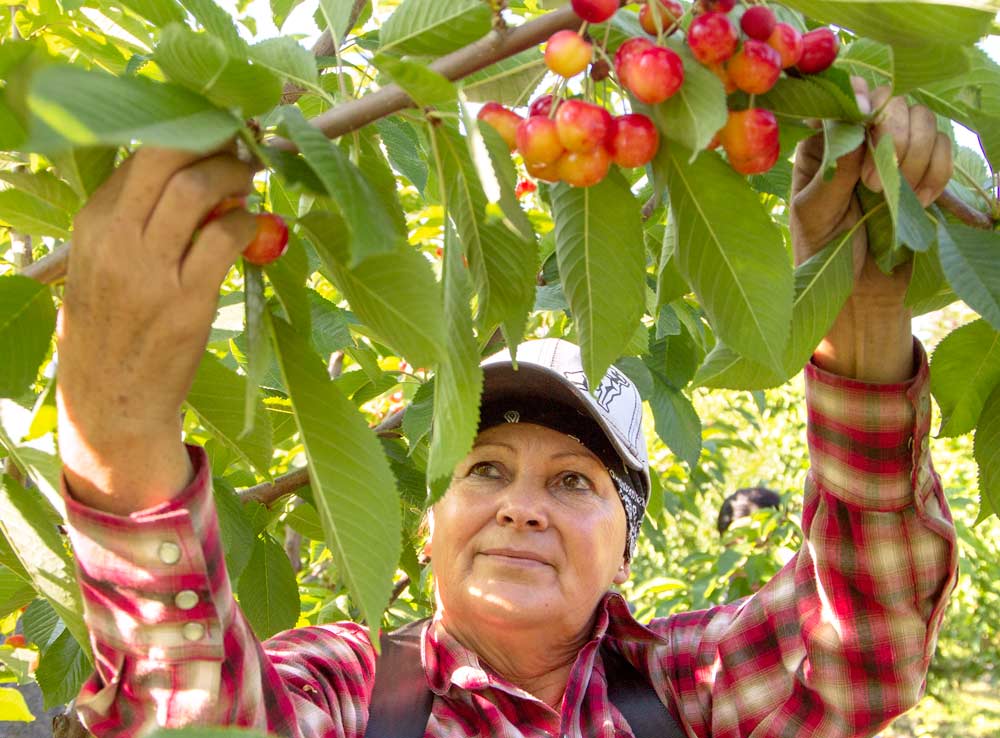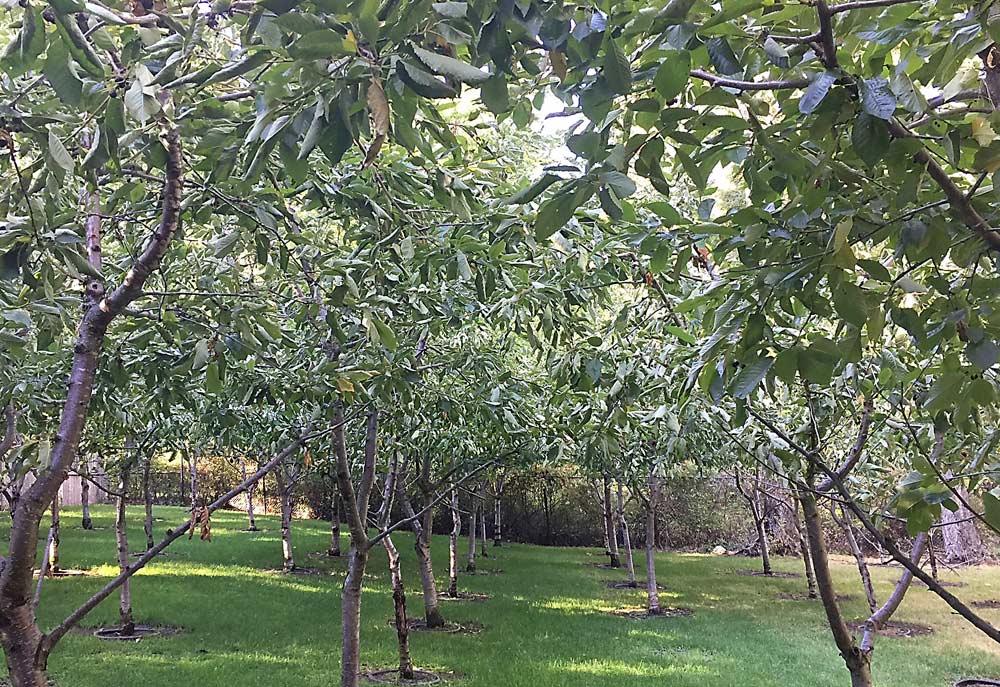
A fifth-year Sweetheart cherry block overlooks Flathead Lake south of Bigfork, Montana in July 2017. Northwest Montana’s warm summer days and cool nights lend themselves to high-quality fruit, but growing cherries in Big Sky country is not for the faint of heart. (Shannon Dininny/Good Fruit Grower)
The warm summer days and cool nights in northwestern Montana’s scenic Flathead Valley, south of the peaks of Glacier National Park, have long been known to foster production of sweet cherries popular among locals and tourists alike.
However, growing cherries there isn’t for the faint of heart, perhaps more so than anywhere else in the U.S.
Big Sky country is famed for its harsh winters and often unpredictable weather.
The region has long held an industry niche as the latest cherries in the country, but as more and more growers plant late-season varieties and at higher elevations in neighboring Washington, Montana growers increasingly find their season squeezed by bigger players to the West.
Montana orchards also are typically small, only about 5 to 10 acres, which makes changing up operations or taking a loss especially hard.
There are other challenges. Several years ago, powdery mildew made its way to Montana for the first time, adding a new wrinkle to the growing season. Last year, Washington’s massive crop sent prices plummeting by midsummer, just as Montana cherries were hitting the market.
And this spring, word came that a private packing house that had been operating locally for more than a decade was closing up shop, sending a dozen or so growers scrambling to find a home for their upcoming crop through the local co-op, which sends fruit to be packed at Monson Fruit in Washington.

Bruce Johnson
“We’ve been at this long enough that we have been on this roller coaster before,” said Bruce Johnson, a grower and president of the Flathead Lake Cherry Growers Cooperative. “We’re being optimistic about this year because we hear that (Washington) has kind of a normal spring going on and some of the early orchards are already blooming. But we’re pretty late … we’re hoping we’ll have a little bit later spring and a bit more separation for us and that prices will be stronger.”
Montana typically produces between 1,500 and 2,500 tons of sweet cherries annually; growers finished a bit light at just under 1,000 tons last year, a smidge compared to Washington’s 220,000 tons.
That behemoth crop, combined with lower sugar in some varieties, also drove down prices, which hurt growers with later varieties both in Washington and Montana and in British Columbia.
Montana growers generally can expect a net return of about $1 a pound on Lapins from the packer. Last year, returns were about half that, said Brian Campbell, field representative for Monson Fruit in Montana.
“The whole Northwest just had a giant crop, overset and small fruit. (Montana growers) used to have a little niche with the tail end of the market, but with all the new varieties, we no longer have any advantage,” he said, adding with a laugh, “They’re just butting in on our turf.”
Sweetheart deal?
For decades, Montana growers were known for their Lambert cherries, a hardy variety able to withstand the region’s harsh winters and popular among buyers at roadside stands, though not ideal for export.
However, when unseasonal temperatures killed more than half the trees nearly 30 years ago, growers replanted largely in Lapins.
The late-season squeeze from the West now increasingly has them looking to be even later.
Montana growers will always have a niche “because there’s a portion of the country that always looks forward to Flathead cherries every year,” said B.J. Thurlby, president of Northwest Cherries, which markets cherries for five states including Montana.
In some ways, Montana competes more with British Columbia’s Okanagan Valley, another late-season region, which produced about 15,000 tons last year, but staying late could be key.

Vern McDermott of Monson Fruit washes Rainier cherries from a member of the Flathead Lake Cherry Growers Cooperative on July 25, 2017. The fruit will be trucked to Washington’s Yakima Valley for packing, with much of it returning to be sold in Montana as local Flathead cherries.
(Shannon Dininny/Good Fruit Grower)
In recent years, two varieties — Pinedale Ruby and Santina — have excited Montana State University Extension agent Pat McGlynn, but she said growers have been slow to adopt them.
It can be hard to get growers to adapt to new varieties because their acreages are so small, McGlynn said. With some 150 small growers in the Flathead Valley producing on just about 1,000 acres, most don’t want to take land out of production to replant — and they don’t want to risk planting something the packer won’t take.
Grower Dale Nelson, who manages his own orchard as well as that of a neighbor, said the only reason Montana growers are competing with Washington is because “they went late and we didn’t.”
Seeing the potential in Sweethearts, which harvest in late August in Montana, he and the neighbor have planted 20 acres. Monson Fruit wrote the plan for the orchard and is invested in its success, he said, giving pruning and spraying advice in the spring.
“They have Sweetheart blocks that are 15 years old, and they know how to grow ’em,” Nelson said. “The only issue is you have to have the foresight to replant.”
Shifting to a new variety is a very big deal for someone with only 10 acres, which is the norm in the region, Johnson said, and keeping labor around for a longer season also could pose a challenge, Johnson said.

Bertha Ambriz picks Rainier cherries at an orchard on the east shore of Flathead Lake in northwest Montana last summer. Ambriz, her husband, and an assortment of relatives from Washington and Oregon have been coming to the Flathead Valley to pick cherries for 16 years, treating the trip as a midsummer vacation between jobs back home. (Shannon Dininny/Good Fruit Grower)
Washington needs 20 times the pickers, and Montana’s later crop has always been timed such that workers travel there, often in family groups, for the month-long harvest as a working vacation — pick fruit by morning, picnic and frolic in Flathead Lake by late afternoon. Child care with educational programming is even available through the co-op.
However, some years there might be a week between harvest of Lapins and Sweethearts, he said, and there have been some problems keeping picking crews.
That should improve as more Sweetheart plantings come into production in the valley, but anyone planning to plant even later varieties had better have a plan for who’s going to pick it and pack it.
The latter became more complicated this spring when Glacier Fresh announced it would be closing its packing house on the east shore of Flathead Lake, after more than a decade of operation.
About a dozen growers quickly filed applications for co-op membership in March; most were accepted after the co-op visited and worked with them on recommendations and standards, Johnson said.

Brian Campbell of Monson Fruit has coined this orchard “Powdery Mildew Hollow” as one that is representative of some smaller orchards in Montana’s Flathead Valley. The lush green grass, watered daily, and the canopy of shade from 80-foot evergreens bordering the orchard create a playground for mildew. (Photo courtesy of Brian Campbell)
Montana, meet mildew
The advent of Sweetheart production in Montana also brought an unwelcome guest to the region for the first time: powdery mildew. The variety is particularly susceptible to mildew, and after some minor occurrences, it finally caught growers off guard two years ago. They often didn’t think about spraying trees until they became more mature, but mildew has largely attacked younger trees, leaving growers playing catch up.
Last season, thanks to advice from former Washington State University researcher Claudia Probst, growers got a better handle on it. They’re just having to do things they didn’t before, Campbell said.
“It’s all about horticultural practices — pruning to let in more sunlight and airflow, pruning out the ground suckers,” he said. “And then in spring, rotating your fungicides.”
He also recommends growers use sulfur more often until close to harvest and let their orchard floor dry up rather than maintain the grassy, park-like setting some growers prefer. “I recommend they just cut back the frequency of the waterings and do a deeper watering a lot less often,” he said. “Let the floor dry out, because it’s that constant humidity that makes it take off.”
Realistically, growers will have to be more vigilant to control it — a requirement that can challenge a grower community comprised of many small, mom-and-pop operations and hobbyists taking advantage of an agricultural tax credit by planting 100 trees.
The latter folks don’t often think about what goes into production, whether it’s labor or orchard practices, Johnson said. That’s one reason the co-op has established a program to manage orchards for those who don’t want to manage their own — a good thing for the Flathead Valley’s cherry community that relies on the name recognition that comes with its product.
“In one way, we have people who are paying attention for Montana cherries, because no matter what the state of the market, they’ll buy Montana cherries,” he said. On the other hand, he said, if consumers are just buying red cherries and the cherries aren’t good, they won’t buy again because they don’t know the difference.
As was the case in 2017, he said.
“After last year, we’ve heard people in Washington are pruning the heck out of their trees,” he said. “We’re optimistic. How can we not have a better year than last year?” •
—by Shannon Dininny






Leave A Comment